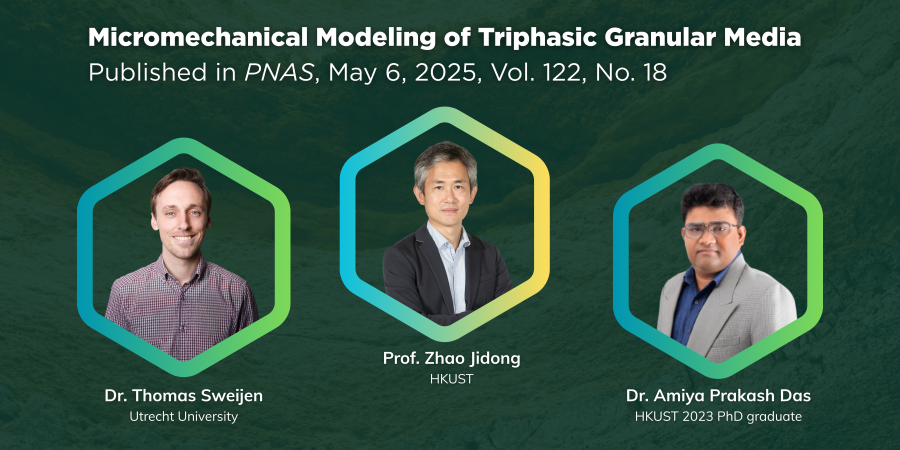HKUST Researchers Develop New Model for Accurate Landslide Prediction with Applications in Sustainable Agriculture, Energy, Healthcare, and Beyond
The Hong Kong University of Science and Technology (HKUST) announced today that a research team from its School of Engineering has developed a groundbreaking computational model to study the movement of granular materials such as soils, sands and powders. By integrating the dynamic interactions among particles, air and water phases, this state-of-the-art system can accurately predict landslides, improve irrigation and oil extraction systems, and enhance food and drug production processes.
The challenge of predicting granular materials
The flow of granular materials – such as soil, sand and powders used in pharmaceuticals and food production – is the underlying mechanism governing many natural settings and industrial operations. Understanding how these particles interact with surrounding fluids like water and air is crucial for predicting behaviors such as soil collapse or fluid leakage. However, existing models face challenges in accurately capturing these interactions, especially in partially saturated conditions where forces like capillary action and viscosity come into play.
PUA-DEM: a paradigm shift in granular modeling
To address these challenges, a team led by Prof. ZHAO Jidong from the Department of Civil and Environmental Engineering at HKUST has developed the Pore Unit Assembly-Discrete Element Model (PUA-DEM). Unlike conventional models that often rely on oversimplified one-way coupling (e.g., static particles), PUA-DEM incorporates rigorous physical principles to govern the dynamic interactions among particles, air, and water phases. This allows for robust multi-way coupling that accurately captures fluid flow, particle movement, and evolving stress and pressure across the entire spectrum of saturation conditions—from fully saturated to completely dry states.
Rooted in fundamental physics, the high-fidelity model is the first of its kind, achieving exceptional precision in predicting complex multiphase behaviors. It holds significant potential to advance applications in geotechnical engineering, environmental science, and many industrial processes.
Broad applications across industries
The team is now exploring collaboration opportunities with the government and industry to apply their model to real-world challenges. That includes developing an early landslide warning system, optimizing irrigation strategies through simulations of water retention and root-soil interactions, and enhancing carbon sequestration and oil extraction efficiency with the model’s accurate multiphase flow predictions. Its precise control of powder processing also offers transformative potential for pharmaceutical manufacturing, enabling safer, more effective, and efficient drug production with enhanced consistency in dosage forms, which is critical for improving therapeutic efficacy and patient outcomes. The model’s capabilities may also extend to the food industry, potentially revolutionizing the design and processing of granular products like coffee, sugar, and infant formula by optimizing texture, dissolution rates, and shelf stability while reducing waste and energy consumption.
Prof. Zhao explained, “PUA-DEM represents a paradigm shift in modeling unsaturated granular systems. By resolving pore-scale fluid-solid interactions, we can now predict how microscopic processes – like capillary bridge formation and particle swelling, govern macroscopic behaviors such as soil collapse or fluid leakage in energy reservoirs. This opens new avenues for designing safer infrastructures, optimizing agricultural practices, improving pharmaceutical manufacturing, and addressing energy-related engineering challenges.”
Future directions: expanding PUA-DEM’s capabilities
Looking ahead, Dr. Amiya Prakash DAS, the first author of this work and a recent HKUST PhD graduate, said the team planned to expand PUA-DEM’s capabilities. “In the next stage of our research, we aim to incorporate irregular particle shapes and wettability effects, further narrowing the gap between laboratory findings and field-scale applications. Future work will also explore hybrid computational strategies to model reactive transport and drying-induced cracking,” he said.
The study was conducted in collaboration with Dr. Thomas SWEIJEN of Utrecht University, Netherlands. The paper, titled “Micromechanical Modeling of Triphasic Granular Media”, has been published in the prestigious academic journal Proceedings of the National Academy of Sciences (PNAS).
About The Hong Kong University of Science and Technology
The Hong Kong University of Science and Technology (HKUST) (https://hkust.edu.hk/) is a world-class university that excels in driving innovative education, research excellence, and impactful knowledge transfer. With a holistic and interdisciplinary pedagogy approach, HKUST was ranked 3rd in the Times Higher Education’s Young University Rankings 2024, 19th Worldwide and No.1 in Hong Kong in Times Higher Education’s impact Rankings. Thirteen HKUST subjects were ranked among the world’s top 50 in the QS World University Rankings by Subject 2025, with “Data Science and Artificial Intelligence” holding the 17th place, maintaining its position as first in Hong Kong. Our graduates are highly competitive, consistently ranking among the world’s top 30 most sought-after employees. In terms of research and entrepreneurship, over 80% of our work was rated “internationally excellent” or “world leading” in the latest Research Assessment Exercise 2020 of Hong Kong’s University Grants Committee. As of May 2024, HKUST members have founded over 1,800 active start-ups, including 10 Unicorns and 17 exits (IPO or M&A).
(This news was originally published by the HKUST Global Engagement and Communications Office here.)


